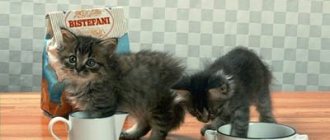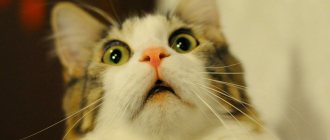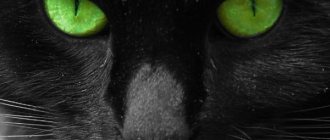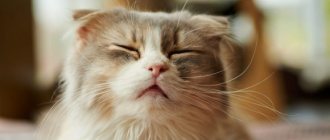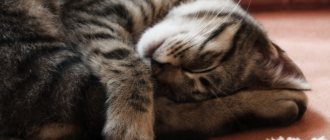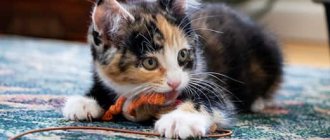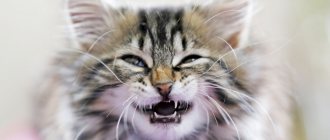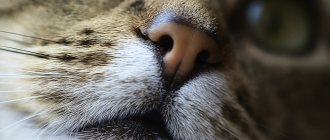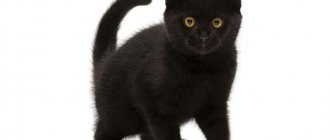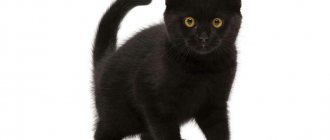The green color of the iris is quite common among cats. The color and shade of the eyes (as well as fur) is determined by the amount of melanin pigment, which is produced by special cells - melanocytes. The more melanin, the more intense the color. Cat breeds with green eyes are also not uncommon—Russian Blue cats or Korats, for example, can boast of the extraordinary beauty of their eyes.
Green shades range from light gooseberry green to deep emerald or even sea green. The most common shade of green is hazel, or yellow-green. Now let's look at several breeds that have green eyes or are even an important breed trait. Let's start with a group of blue cat breeds.
Russian blue
The origin of this breed has not yet been fully studied. According to one of the existing theories, such cats were brought to England from the Russian city of Arkhangelsk. Their extraordinary appearance and mysterious origin contributed to the rapid spread of these animals throughout the world. In 1939 they received official recognition and their current name.
The Russian Blue is one of the few breeds of gray cats whose standard does not allow any other colors. These animals have a slightly elongated muscular body with a slender neck, oval paws and elongated limbs. The wedge-shaped head has large, forward-sloping ears and large green eyes. The graceful body of representatives of this breed is covered with short silky fur with a thick undercoat. The cat's fur coat is painted in a uniform blue color with a clearly visible silver tint. Despite their good-natured and obedient disposition, these cats are capable of showing independence and stubbornness. In addition, they have a well-developed hunting instinct, so they make good rat catchers.
Color options
Breeders spent many years and effort trying to develop a cat with the perfect blue color. The main quality of this shade is the absence of red pigment. This coat color is extremely rare. A lilac color with a warm tint is allowed only for some breeds.
The so-called shaded gray looks like this: a third of the hair goes gray, the rest is white. Chinchilla color - 1/8 of the hair is gray, the rest is white.
Chinchilla color
Interestingly, gray coloring is not found in many native breeds. An attempt to fix the blue tint in Siberian cats led to the fact that the coat changed both color and structure. Therefore, they decided to stop further breeding work.
Gray color is typical for British cats. Their fur is often blue in color and can also be light gray or dark gray. There are also gray-blue “British” cats with evenly colored fur of a rich blue hue. Any color impurities and stains are rejected.
The blue color is combined with a striped, spotted, marbled pattern. Interspersed with red, cream, white, peach, and black colors are allowed.
Possible eye colors
The blue shade of the coat goes well with green, orange, and amber eyes. Siberian and Angora cats have silver or blue irises.
Chartreuse
According to one legend, the first representatives of this small breed of gray cats were brought to France during the Crusades. According to another version, they appeared as a result of targeted selection. If you believe this theory, then their ancestors are Pallas' cats and Egyptian cats. Be that as it may, Chartreuse received official recognition only in 1939.
Representatives of this breed of gray cats have a strong, dry body with a short neck and well-developed muscles. On the round, wide head of the Chartreuse are high-set ears and beautiful golden eyes. As for color, it varies from ashy to blue-gray.
These cats have a calm, silent character. They are very patient with children and show intelligent restraint towards strangers. Chartreux quickly adapts to any conditions and remains calmly alone. They are quite playful and retain this valuable quality until old age.
Are there differences in character and behavior?
Blue cats are aristocrats not only in appearance, but also in behavior. They are characterized by the habits of a high-born animal, supposedly having not only a blue fur coat, but also blood of the same color.
They have an independent, proud character. From a young age they try on the role of master in the house; they simply do not accept any other status. At the same time, gray kittens develop such qualities as calmness and nobility even in childhood.
Growing up, they do not change for the worse; they are completely devoid of anger. They often have a playful disposition, but it happens that a cat grows up quite withdrawn and keeps its distance from others.
Did you know? The first cat astronaut was the French cat Felicette, which means Astrocat. This significant event took place in 1963.
Solid blue cats are intelligent and curious. Extremely loyal to the owner. Don't let this surprise you, but it happens. They love to sleep in the arms or chest of their owner, or simply spend an afternoon siesta there.
Loneliness does not frighten them. They will always find something to do to their liking when the owner is not at home. Moreover, their regal manners do not go away, and most often, cats of this color do not allow themselves to stoop to the pranks inherent in carriers of other colors. So feel free to leave your pet alone without fear of returning home to complete chaos.
Nibelung
Representatives of this breed of gray cats are considered descendants of the famous Russian Blue. Nibelungs are not very large animals. The average weight of an adult does not exceed five kilograms. They have a slightly elongated body with well-developed muscles and a long neck. On a small wedge-shaped head with a high forehead and a specific nose line, there are rectangular ears and expressive green eyes. The body of the Nibelung is covered with fine silky hair that is not prone to matting. The fur of these animals is always blue with a silver tint.
Representatives of this breed seem to be created for life in a confined space. They adapt well to being kept in small apartments, but if they are given complete freedom and a large fenced yard, they will behave like real hunters. Nibelungs are distinguished by their intelligent, peaceful disposition. These cats are not prone to competition with other animals.
Health
Thanks to the genes of their ancestors, Anatolian cats are very strong and have excellent health; their immunity copes well with parasites, viruses and infections. These troubles do not happen to them often. And serious illnesses even more rarely affect representatives of this breed. If you take proper care, your cat can live with you for more than 15 years.
If your plans do not include breeding the breed, it is better to castrate or sterilize your pet. Sterilize after the animal is 8 months old, and preferably up to a year. The maximum age for this procedure is 2 years; after this milestone, health problems may arise. Castration is carried out from 10 months to 2 years
It is important to carry out these manipulations before the cat matures and its habits are formed. In addition, the younger the cat, the faster he will get back on his feet.
Early surgery is also not recommended, otherwise it will cause developmental delay.
After the operation is done, you need to provide your pet with adequate care to prevent possible complications. Entrust your little friend only to a trusted doctor, and after the operation follow these rules:
- the cat needs peace, rid the animal of noise;
- there is a danger that the pet will lick the seams too actively and they will come apart, so provide him with a special belt-blanket;
- food can be given only after 12 hours;
- check the condition of the seams daily, treat them with Chlorhexidine or peroxide;
- stay nearby, don’t let them move too actively;
- You can give an anesthetic if the veterinarian gives the go-ahead and indicates the dosage.
To purchase an Anatolian cat, you need to contact only trusted breeders and nurseries. Anatolians are bred in Greece, Germany, Holland, Ukraine, Belarus, Russia. There are no nurseries in our country, but there are quite a few breeders specializing in this breed.
You can learn more about the intellectual abilities of Turkish cats from the video below.
Korat
This is one of the oldest breeds of gray cats. The name "korat" can be seen on the pages of Thai books published in the years 1365-1770. The ancestors of modern representatives of this breed were wild silver-blue cats that lived high in the mountains. In 1959, the first Korats came to America and aroused considerable interest among professional breeders. From that moment on, they quickly spread throughout the world and gained popularity among cat lovers.
Korats are not very large animals with a strong muscular body. The weight of an adult varies from 2.5 to 5 kilograms. Moreover, females are noticeably smaller than males. They have a slightly elongated body with a wide chest and a straight back. Under the cat's body are strong, sinewy limbs. The Korats' front legs are slightly shorter than their hind legs. The broad, heart-shaped head has round green eyes and neat, movable ears. Korats are a fairly popular breed of gray cat (photos of these animals can be seen in today’s publication). They are very smart, sociable and curious.
Causes of yellowing eyes in cats
Yellowing of the sclera in a cat is not noticeable due to the large size of the iris. Even an attentive owner notices the icterus in the whites of the animal’s eyes against the background of a general deterioration in the condition of his pet, a change in his appetite or yellowing of the inner surface of the ear or the skin of the pads. Not only the sclera or the lining of the ear turns yellow, the cat’s entire skin changes color, the tongue and all visible mucous membranes become lemon-colored. This condition is called jaundice.
Jaundice, as a symptom, always indicates a high concentration of a substance such as bilirubin in the animal’s blood. It is a derivative product during the normal processing of hemoglobin from red blood cells, which the body needs to transport oxygen to every cell and organ. If hemoglobin is processed at an accelerated pace (under pathological conditions), then soon too much bilirubin will accumulate. Then yellowing of the whites of the eyes and mucous membranes occurs.
In addition to jaundice, your cat will have other signs of illness:
- indigestion;
- flatulence;
- diarrhea or vomiting;
- extreme thirst and excessive urination;
- labored breathing;
- hepatic encephalopathy;
- dark urine and light feces;
- Also, in the last stages of the disease, the animal may experience internal bleeding, and, as a result, blood in the urine and feces.
This condition is far from normal. The animal eats poorly, loses a lot of weight, may suffer from severe pain, and fall into a coma. In the absence of timely medical intervention, the pet may die.
Such a manifestation as jaundice is usually differentiated into parenchymal, mechanical or obstructive and hemolytic forms. Each form is caused by serious pathological processes in the cat’s body:
- Hepatic or parenchymal jaundice is caused by functional and organic diseases of the hepatobiliary system. Hepatitis (inflammation of the liver parenchyma), cholangitis (inflammation of the bile ducts) cause icterus in animal tissues.
- Severe liver diseases: cirrhosis (replacement of the organ parenchyma with connective tissue with loss of its functionality) and cancer lead to yellowness of the skin and mucous membranes. Even excessive accumulation of triglycerides (fats) by liver cells - hepatocytes - leads to yellowness of the sclera and skin.
- Baked obesity, or lipidosis. In this condition, liver cells develop into fat cells. The liver gradually loses its functions, which means the animal may die. Its causes are the cat's excess weight, diabetes, malignant tumors, and hyperthyroidism. Unfortunately, in almost half of the cases the cause of this dangerous disease cannot be established.
- The use of certain medications can lead to changes in the liver and excess bilirubin (bile pigment) in the cat's blood. It is the bile pigment that colors tissues a beautiful yellow color. These medications include: first generation antihistamines (diazolin), NSAIDs (paracetamol), antifungals (griseofulfin).
- Infectious diseases of viral etiology (viral peritonitis), protozoal infections (toxoplasmosis), bacterial pathologies and some parasitic infections cause liver pathology and the release of large amounts of bilirubin into the blood.
- Incorrect use of insectoacaricides (veterinary products intended to combat parasitic insects, in particular ticks). Many insectoacaricides have a strong toxic effect on hepatocytes. Salts of heavy metals also have a similar effect.
- Obstructive jaundice. Obstructive jaundice develops when there is an obstruction to the outflow of bile. Most often it develops due to exacerbation of cholelithiasis (cholelithiasis). If concretions (stones) block the bile duct, the animal develops biliary colic, the temperature may rise, and it is bothered by severe pain in the right hypochondrium. The mucous membranes, sclera and skin turn yellow.
- Inflammatory diseases of the gallbladder and its ducts, their stenosis, pancreatitis, pancreatic cancer can lead to impaired outflow of bile and jaundice. Any tumors of the abdominal cavity that grow into the tissue of the bile ducts or mechanically compress the gallbladder and its ducts can cause large amounts of bilirubin to enter the bloodstream and cause yellowing of the animal’s tissues.
- Hemolytic jaundice. Hemolytic jaundice is caused by hemolysis (destruction) of red blood cells directly in the blood vessels. This happens in some diseases (hemolytic anemia). The cause of hemolysis of erythrocytes may also be severe hypophosphatemia, aggravated by magnesium deficiency. Hemolysis can develop as a result of a cat’s body’s reaction to a blood transfusion. The entry into the blood of hemolytic poisons (zoocoumarin) and medications (warfarin) also leads to the destruction of mature red blood cells.
- Parasitic diseases: feline hemobartonellosis, feline piroplasmosis can lead to hemolysis of hemoglobin. Parasitism of certain helminths that attack vital organs can lead to hemolytic jaundice. This disease in veterinary practice is called dirofilariasis.
American Curl
These animals were bred by pure chance. In 1981, in one of the American states, breeders selected a cat with unusual curling ears. Soon after this, she gave birth to two babies, who inherited her unusual appearance. It was these kittens that became the ancestors of the American Curls. This breed received official recognition in 1986 and quickly gained popularity among professional felinologists.
American Curls are cats with a strong body, straight limbs and well-developed muscles. On the proportional wedge-shaped head are elliptical eyes and high-set, backward-curved ears. The rectangular body of these animals is covered with short or semi-long hair. Among the representatives of this breed of gray cat with blue eyes, there are often individuals of other colors. But this is the most common color. As for character, American Curls are very inquisitive and playful. They have a natural sense of tact and innate accuracy. These good-natured, cute creatures get along well with other pets, including birds and small rodents.
British Shorthair
These animals will certainly interest those who want to learn about the breeds of gray cats. England is considered their homeland. It was there that serious work was carried out to create this breed. Among their ancestors are Persians and ordinary London cats that lived in city parks. In 1898, the British were recognized as a separate breed. The official standard was approved even later.
Outwardly, the British give the impression of massive and clumsy animals. The average weight of an adult is from 4 to 8 kilograms. But sometimes there are cats whose weight reaches 12 kg. These are powerful, muscular animals with a wide chest, short thick neck and heavy paws. On a rounded head with weighty cheeks and an interesting line of the mouth there are large golden eyes. The Briton's massive body is covered with thick short fur. The most common color of this breed is considered gray. But the standard allows other options.
Persian cat
This is one of the most popular and recognizable breeds. It was developed in the 16th century and quickly spread throughout the world. Of course, those Persians were very different from those we see now. But in those distant times the breed was just beginning to take shape. German and British breeders worked on its development.
Modern Persians have a massive body with a wide back and powerful chest. Under the large body there are thick short legs. The large round head with strong jaws has an upturned nose and rather small, widely set ears. The entire body of Persians is covered with long, luxurious hair. As for the color, it can be anything. The most common species are blue, red, tortoiseshell, cream and black. The first representative of this gray cat breed was registered in 1887. Since then, such animals have been actively used in breeding, and they have gained immense popularity.
Breeds of long-haired cats: the beginning of history
There are two versions of the origin of long-haired cats:
- In the cold northern climate, long hair protected from frost and helped animals survive the long winter.
- Representatives of the southern regions acquired a long-haired coat to improve heat exchange - a thick layer of hair prevented the cat’s body from overheating in direct sunlight.
Later, in the 19th century, there was a great migration of cats to the European continent, where interbreeding began.
This is interesting! There are more than 250 cat breeds in the world, a third of them are long-haired animals.
Scottish lop-eared
These animals are very similar to the British. They appeared due to a random mutation. The Scots have a small, powerful body with well-developed muscles and a broad chest. On the rounded head of these animals there are large eyes and ears curved forward and down. Their body is covered with thick, short and very soft hair. As for the color, it can be anything, including blue, red, lilac and chocolate.
Having figured out what breed a gray cat with unusual floppy ears is, you need to mention its character. Scots are very friendly and affectionate creatures that need constant attention. They quickly get used to their owners and do not require special care.
Care
Caring for such animals is not at all difficult. They don't require much attention. The only condition is that they need to be combed periodically. Once a week will be enough. This will allow the cat to look not only beautiful, but also elegant.
However, if the pet has long hair, then it needs to be brushed almost every day. You should use a special comb with blunt teeth so that the cat does not get hurt. From time to time you need to bathe your pets using special shampoos. If the cat lives in the house and does not walk outside, it is enough to bathe it 2-3 times every 6 months, or do this as it gets dirty.
Don’t forget about proper feeding of such cute pets. For this you can use both industrial feed and natural food. If preference is given to the former, then you need to buy them in special stores and only of the highest quality. In spontaneous markets, they may be of low quality and therefore contain few useful substances.
If you prefer natural food, you need to take care of a complete diet for your pet. It should include:
- boiled meat, preferably chicken or beef;
- boiled vegetables;
- some offal, it’s good if it’s boiled liver;
- sea fish;
- various cereals, for example, rice, buckwheat or oatmeal;
- some greenery;
- vitamins that can be purchased at a veterinary pharmacy.
In the next video you can learn about the origin and main characteristics of Scottish Fold cats.
TOP 6 cat breeds with blue or smoky coat color - list, characteristics and photos
The soft, unobtrusive gray color of cat fur in some sense adds even more coziness to the home environment. Therefore, cats of gray color (among breeders it is customary to call it blue) are popular, regardless of their origin. Nevertheless, there are breeds that are simply irresistible in this particular color. And in several of them, blue coat color is one of the breed-forming characteristics. But, despite its popularity, it cannot be called common. Of course, this is due to the peculiarities of inheritance.
Blue coat color is a light version of black. In order for it to appear, the kitten must receive: firstly, a coat lightening gene - necessarily from both parents, and secondly, a gene called “non-agouti”, which suppresses the manifestation of the pattern - also from both parents. It is not surprising that many times fewer monochromatic cats with light-colored fur (not necessarily blue) are born than patterned and dark ones.
The blue color has, figuratively speaking, a “subspecies” - smoky. For its manifestation, a gene is required to suppress pigment synthesis as the hair length increases. That is, at the beginning of growth (at the tips), the hairs are normally colored, but with each millimeter they become lighter, and at the roots they are completely devoid of pigment. This gene is called conditionally dominant, since its manifestation is individual.
Features and genetics of color
The coat looks gray with unevenly distributed black pigment. If you look at a hair under a microscope, you can see that there are white spaces between the black areas. The amount of carbon pigment in the bulb itself does not affect the color: gray cats have the same amount of it as black cats. An ashy shade is obtained when eumelanin fills only part of the pigment cells of the hair, and some remain uncolored. In this case, filled and empty cells alternate not one at a time, but in small clusters. The ratio of the sizes of the white and black zones on the hair determines how light the shade will be.
If the light area is at the tips of the bristles, a silvery tint appears in the color.
Gray cats are carriers of the dominant black gene. Genetically, their difference from black cats is not associated with the white gene - this gene is the strongest of all, and if it is dominant, regardless of the set, a white kitten is born. The difference in color is due to the color density gene. Being dominant, it determines uniform staining of cells and vice versa. That is, in gray cats, unlike black cats, it is recessive.
A solid gray color, without spots or stripes, is called blue. It is possessed by cats that do not have the dominant agouti gene that determines the pattern. The eyes of these cats are usually brown, yellow or green. The nose and pads on the paws often have a gray-blue tint.
If the genes for black color and density turn out to be recessive, and there is no dominant red gene responsible for the orange pigment (pheomelanin), the gray coat color will have a warm tone. This color, if solid, is called lilac.
Russian blue
A slender, muscular cat of medium size, on high legs, with a proportional wedge-shaped head and high-set ears. The calling card of the breed is its unique color, blue with silver tipping (lightened hair tips). It feels like the cat's coat is dusted with snow. She looks absolutely stunning with bright green eyes! The coat of Russian Blues is short and very thick - according to the standard, the hairs should be located vertically to the skin.
The history of the breed (like many other old breeds) is complex and somewhat confusing. But it is known that neither Russians nor modern Russian breeders have anything to do with its creation. These cats were bred at the beginning of the last century in Great Britain - based on animals imported from Arkhangelsk. At least that's what the most common version says. However, cats from other regions and representatives of other breeds were also involved in selection.
Nibelung
Nibelungs are called the long-haired version of the Russian Blue, since representatives of this breed were actively involved in their selection. Indeed, their appearance is similar, and the tips of the Nibelung's hairs also have silver tipping. But there are also differences. First of all, it is long (more precisely, semi-long) thick fur, more developed muscles, and not such a bright eye color. This is a smart, good-natured and affectionate cat.
Despite the obvious relationship, the “founding fathers” of the breed were ordinary mongrel cats that were born in the United States in the 80s of the last century. Their owner logically reasoned that her unusual animals were worthy of the attention of the geneticists of the TICA felinological system. Indeed, she managed to interest specialists, and a decision was made to create a new breed. It received a beautiful legendary name for two reasons. The word "Nebel" means "fog" in German, which suits her appearance very well. And of course, in honor of the famous German epic.
Personality of the Russian Blue cat
Russian Blue in the arms of the owner
Russian Blue-haired cats can be classified as problem-free pets. Whims, self-will, deliberate sabotage - all this is beyond the understanding of plush aristocrats. Thanks to their innate intelligence and exceptional sensitivity, Arkhangelsk cats give the impression of being somewhat dependent, but one cannot accuse them of being too soft. Russian blue cats are sweet and spontaneous only with their own household. This rule does not apply to strangers and unfamiliar people, so do not be surprised if, upon seeing guests on the threshold, your pet immediately makes a move.
It is believed that representatives of this breed are lenient towards children's pranks and do not lose their composure in situations in which any other cat would have long ago released its claws and issued a battle cry. However, leaving a small child and an animal alone is always an unjustified risk. In relation to other pets, “archangels” are quite loyal. Moreover, cats are ready for a peaceful dialogue with any representative of the fauna, unless he makes attempts to provoke.
The Russian Blue cat’s favorite place is not the owner’s lap or even a well-appointed MDF house, but any piece of furniture at least one and a half meters high, which, like Everest, is subject to immediate (and often repeated) conquest. As for affection, the mustachioed intellectuals accept it quite favorably, but they will not allow themselves to be squeezed to the point of fainting. In addition, in the soul of even the laziest Arkhangelsk cat, a primitive hunter is lightly dozing. This means that getting a mouse or other unwary rodent for a pet is a matter of honor.
In the absence of conditions for full-fledged hunting (applies to individuals living in city apartments), Russian blue cats begin to make do with catching flies and other insects. For this reason, it is not recommended to leave animals in rooms with open windows and balconies. In pursuit of winged prey, pets lose their vigilance and often “fly” outside the apartment, causing injury to themselves.
Chartreuse
This is a large, strong, muscular cat, with a rounded head, small ears, large expressive eyes of yellow or copper color, and a pleasant, friendly expression on its cheeky face. The coat of the Chartreuse (exclusively blue) is short and very thick. Chartreux are naturally trained, calm, observant and affectionate. As a rule, they choose their favorite from the family, but find a common language with everyone.
This breed was bred on the basis of cats that appeared on the territory of France during the Middle Ages - it is generally believed that the Crusaders brought them with them. Their homeland is the mountains of Turkey and Iran with very harsh living conditions, which explains their extremely thick fur and excellent hunting skills. This is one of the oldest European cat breeds, the pride of French felinology, it was bred at the beginning of the last century.
Turkish Angora: characteristics of the breed
There are various breeds of white cats, but perhaps the most famous of them is the Turkish Angora - a harmoniously built, flexible and graceful animal with large, almond-shaped, wide-open eyes, set somewhat obliquely. Originally, this type of cat was only white with blue, orange, green, amber, yellow or different colored eyes.
There are various breeds of white cats, but perhaps the most famous of them is the Turkish Angora. The tail of this beauty is much longer than that of other breeds, resembles a peacock feather and can reach the shoulders.
This breed was formed in Turkey, where it is still highly valued today. Cats with different eyes are especially valued, despite the fact that white Angoras with different-colored eyes are deaf in the ear on the same side as the blue eye.
Korat
An elegant, medium-sized cat, flexible, strong, muscular but not ponderous, with an amazing heart-shaped head, shiny short fur with a thin undercoat and olive green eyes. Korats have a very lively, sociable character, they do not like loneliness and love to take part in all household chores.
The homeland of Korats is northern Thailand. These cats have been known for hundreds of years and were mentioned in the famous Thai treatise on cats. Korats were brought to Europe more than a hundred years ago, but breeders were not interested. Moreover, they were called a “breeding marriage of Siamese.” Only in the middle of the last century, American breeders imported several cats from Thailand and developed a breeding program to develop a new breed.
Maine Coon
The Gulliver cat cannot be confused with any other breed. A long body, high strong legs, powerful paws, a luxurious tail, lynx tufts on the tips of the ears and, of course, an indescribable expression on the face, serious and good-natured at the same time. The Maine Coon's coat is not very thick, but it is quite long. Breed standards allow many colors. And there is no doubt that a blue Maine Coon (like any other) looks very stylish! These are smart, playful, sociable, but unobtrusive cats.
The Maine Coon is one of the most famous, recognizable and popular breeds bred by American breeders. However, selection, in the modern sense, began only in the middle of the last century. Meanwhile, evidence of the existence of these cats dates back to the middle of the 20th century: the first known Maine Coon made a splash at a country fair, striking the public with its impressive size and shaggy appearance.
Cost comparison table for tabby cat breeds
The table shows prices for tabby cat breeds in dollars and rubles.
| Breed | Price in US dollars | Price in Russian rubles |
| Asian tabby | 800-1000 | 58000-73000 |
| American Shorthair | 200-500 | 14000-30000 |
| American Curl | 100-2000 | 7000-145000 |
| Bengal | 400-1000 | 29000-75000 |
| American Bobtail | 500-1500 | 36000-110000 |
| Bobtail Kurilian | 100-300 | 7000-22000 |
| Bobtail Karelian | 800-1000 | 58000-73000 |
| British | 500-1500 | 30000-110000 |
| European Shorthair | 800-1000 | 58000-73000 |
| Cymric | 350-850 | 25000-60000 |
| Maine Coon | 600-1500 | 45000-110000 |
| Manx cat | 400-1000 | 30000-730000 |
| Norwegian forest | 350-850 | 25000-60000 |
| Oriental | 400-1000 | 30000-73000 |
| Pixiebob | 400-1400 | 30000-100000 |
| Serengeti | 700-2000 | 50000-145000 |
| Siberian | 1000-2000 | 73000-145000 |
| Soukok | 400-600 | 30000-45000 |
| Toyger | 500-3000 | 35000-220000 |
| Exotic | 130-1050 | 10000-75000 |
British shorthair and longhair
It would be unforgivable to forget about the Briton - with his magnificent, thick double coat of “untwisted” blue color and amber eyes! Most cat lovers perceive them in this color variation. Meanwhile, this massive, but compact, well-proportioned cat with an important expression on her cheeky face can be of almost any color - no less spectacular than blue!
The British are one of the most famous and popular breeds bred in the UK. Persians were involved in selection (this was required after World War II, when the breed was on the verge of extinction). The long Persian coat gene has been making itself felt for many generations. Long-haired kittens were not born very rarely, but were considered a breed defect. However, they were beautiful, and enthusiasts decided to form a standard for a new breed.
Blue and smoky colors are allowed by many breed standards, but are rare in most cases. In addition, these are one of the most capricious colors of a cat's fur coat - if not the most capricious. The fact is that the quality of color is affected not only by age (in all older animals the fur coat somewhat loses its beauty), but also by sunlight, as well as nutrition. Intensely colored food gives it a dirty tint.
Which cat breeds have specific eye colors?
The color of the iris, like the color of the coat, certain characteristics of the breed (fur length, weight, body shape, etc.) are inherited. Different breeds have their own characteristics, including the shade of the iris. Certain colors are included in the list of characteristics approved by international standards, and if a kitten is born with an atypical eye color, it may be disqualified. What representatives of the cat family look like with different eye shades can be seen in the photo below.
Yellow eyed cats
Burmese Shorthair One of the most common iris colors is yellow.
What breeds are characterized by yellowish, orange, golden eyes? Most often, warm, sunny shades are found in ginger cats, and this color occurs in many breeds. Golden eyes are also combined with a gray, white, brownish, smoky, striped, tricolor coat.
Characteristics of yellow-eyed cat breeds:
| Breed name | Coat color | Characteristic |
| British Shorthair |
| The breed was bred in the 19th century. The body is squat, the head is round, the legs are short and thick. |
| Canadian Sphynx | Hairless cat | Registered in 1966. Lack of fur is caused by mutations. |
| Burma | Chocolate with dark brown areas. | Registered in 1934. Medium size, rounded head, thick and soft fur. The color of the eyes changes depending on the lighting. |
| Somalia |
| Descended from the Abyssinian breed, as a result of mutation the hair became long. The body is elongated, large, but graceful. Well-furred tail, like a fox's. |
| Persian | About 100 varieties of color:
White cats are a separate subspecies of the breed and often have congenital deafness. | One of the oldest long-haired breeds. A distinctive feature is a small and snub nose, a long body. |
| Exotic | About 100 varieties of color. | Bred by crossing Persian cats with American Shorthairs. A characteristic feature is short hair, pronounced stop, cheeks. |
| American Shorthair | More than 80 color and pattern options - from solid to striped. | They were brought to America by settlers from Europe. Large, powerful body. Very calm and affectionate. |
| Scottish lop-eared | Plain:
Striped:
| A distinctive feature is that the ears are curved downwards. |
| Bombay | Black | Miniature "panther" with smooth short hair. |
The most beautiful gray and smoky rocks
The gray or smoky color of a cat's coat is a symbol of thoroughbred and nobility.
Under the sun, cats' fur coats can be blue or charcoal gray, and at dusk they can have a silver and platinum color.
British shorthair cat
The appearance of the British shorthair from Foggy Albion amazes with its beauty at first sight. The average weight of cats is from 4 to 6 kg. Sometimes there are representatives of the British up to 8 kg in weight. A large physique does not prevent cats from being dexterous and graceful.
British shorthair cat
The pet's fur is soft to the touch and appearance, similar to plush fabric. The deep gray color was passed on to the British cats from their ancestor - the Persian. Eye color varies from yellow to red-orange.
The temperament of British cats is Nordic. They are calm, balanced and patient.
Otherwise, the British are excellent nannies, steadfastly enduring the games of small children. Representatives of this breed are attached to their owners, but do not show excessive intrusiveness.
Most often, handsome British Shorthairs are bred for home keeping. Pets easily get along with other household members and brothers.
Persian
Representatives of Persian cats are radically different from their gray counterparts. The appearance of pets cannot help but make you fall in love with yourself. The majority of the bodies are medium to large. The weight of cats reaches 8 kg, but on average 5-6. Kitties are a little smaller – 3-4 kg. The structure of the head and the shape of the muzzle divides Persians into 2 types. Classic - the nose is shortened, but wide and has an upturned position. Extreme - the muzzle is flat, slightly depressed, and the nose is snub-nosed and small.
Persian
The coat can be short or long. It is soft to the touch and shiny in appearance. The eyes are round and the color varies in a wide range of blue and orange tones.
The character of Persian cats is willful, but without malice. They are adapted only for living at home; they cannot stay in the wild for long. They get along well with children and are moderately playful. They get along well with other animals only if they are of the same age. They quickly become attached to the owner, choosing only one family member. They need attention, affection and care. By temperament they are not aggressive, not loud.
Breed standards for gray color
Gray color belongs to the group of solid (solid, self). The European Felinological Federation introduced a system of color designation indices. The personal blue color code is indicated by the letter “a”.
Table: requirements for blue color
| Options | Standard requirements |
| Color |
|
| Paw pad color | To match the main coat color (any shades of gray) |
| Nose speculum color | |
| Eye color |
|
Reasons for disqualification:
- colored hairs in color;
- uneven color along the entire length of the hair;
- cloudy or faded eye color;
- blurry rims around the iris;
- Various spots on paw pads and tip of nose.
Experts recommend distinguishing between smoky individuals and gray pets. Smoky cats were identified as a separate group in 1983. The official name of the color is smoke. At first glance, smoky cats are absolutely similar to monochrome ones, but in the dynamics it becomes noticeable that the animal’s fur has a white undercoat. The sharper the contrast between the main coat and the undercoat, the better the quality of the smoky color.
